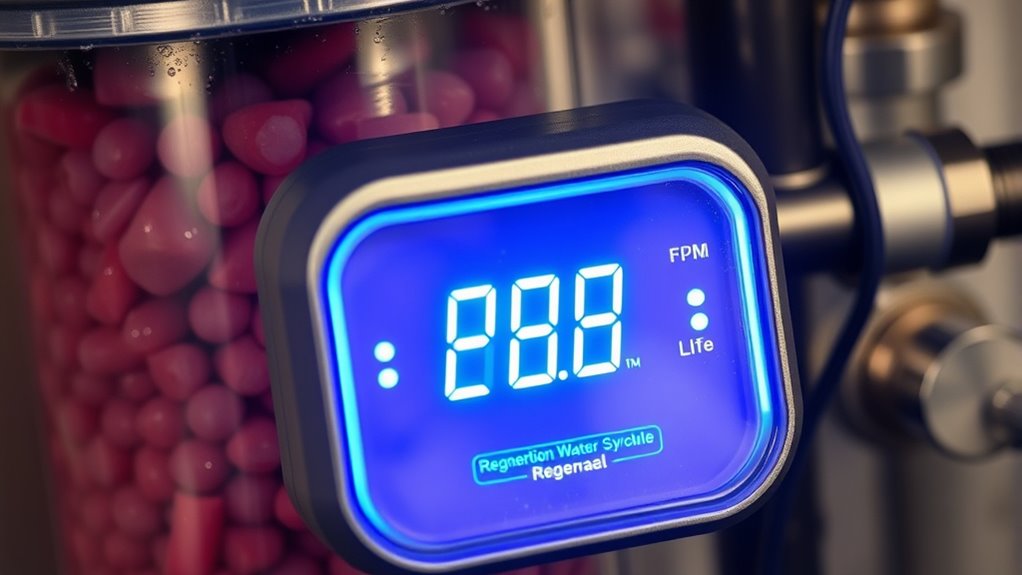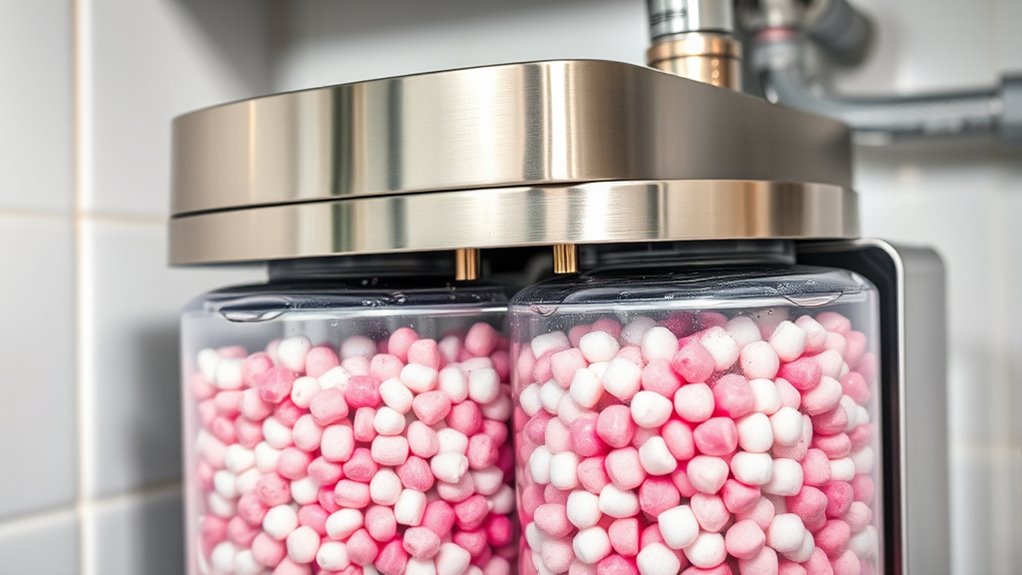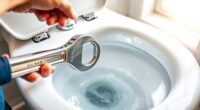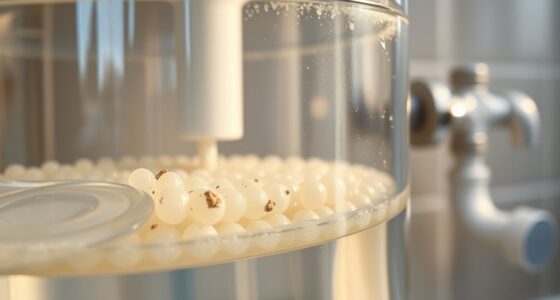Most water softeners need to recharge every 3 to 7 days, depending on your household’s water usage, water hardness, and your system’s capacity. High usage or very hard water may require more frequent regenerations every 2-3 days, while smaller households or softer water might need it less often, like weekly. Modern systems often adjust cycles automatically. Staying attentive to signs of hard water and maintaining proper schedules can keep your system running smoothly and efficiently.
Key Takeaways
- Typically, water softeners regenerate every 3 to 7 days, depending on usage and water hardness.
- High water usage or very hard water may require more frequent regeneration, around every 2-3 days.
- Modern systems often automate regeneration scheduling based on capacity and consumption patterns.
- Regularly monitor salt levels and system performance to adjust the regeneration cycle as needed.
- Proper maintenance and understanding of your system’s capacity help optimize regeneration frequency and efficiency.

Water softener regeneration is a crucial process that restores your system’s ability to remove hard minerals from your water. When your water softener regenerates, it flushes out the accumulated minerals like calcium and magnesium, which cause hard water issues such as soap scum, scale buildup, and reduced appliance efficiency. Understanding how often your softener needs to regenerate depends on several factors, including your water usage, the hardness level of your water, and the capacity of your system.
Water softener regeneration restores mineral removal, preventing scale buildup and appliance issues.
If you don’t keep an eye on your regeneration frequency, your water softener may not work effectively. Too infrequent regeneration can lead to mineral buildup in your pipes and appliances, worsening hard water issues and decreasing their lifespan. Conversely, excessively frequent regeneration wastes salt, water, and energy, increasing operational costs unnecessarily. To find the right balance, you need to consider your household’s water consumption and the hardness level of your water.
Typically, a water softener should regenerate anywhere from once every 3 to 7 days. Many modern systems have built-in controls that monitor usage and automatically trigger regeneration at appropriate intervals. For households with high water usage or very hard water, regeneration might be needed more often—possibly every 2 or 3 days. Conversely, for smaller households or those with softer water, regeneration might only be necessary once a week or less. It’s essential to monitor your system’s performance and adjust the regeneration schedule if you notice signs of hard water issues returning, such as soap not lathering well or scaling on fixtures.
You can also manually set or override regeneration cycles if you notice that your system isn’t regenerating as often as needed or if your water usage fluctuates considerably. Many systems allow you to customize the regeneration frequency based on your household’s specific needs. Regularly checking the salt levels in your brine tank is another key step. When salt runs low, your system may not regenerate properly, leading to hard water issues. Additionally, understanding system capacity and efficiency can help optimize regeneration frequency and keep your water softener functioning effectively.
Frequently Asked Questions
Can I Manually Trigger Water Softener Regeneration?
Yes, you can manually trigger the regeneration process on your water softener. Most models have a manual trigger option, often a button or switch, allowing you to start the regeneration process whenever needed. This is useful if you notice a drop in water quality or want to ensure your softener is fresh. Just follow your specific unit’s instructions to initiate the manual trigger safely and effectively.
What Are Signs My Water Softener Needs More Frequent Regeneration?
Think of your water softener like a tired worker; when it’s exhausted, it needs a break. Signs include your soap not lathering well, spots on dishes, or a reduction in water pressure. If you notice these, check your salt levels and resin exhaustion. When resin gets depleted or salt runs low, your softener struggles, signaling it’s time for a recharge to keep everything flowing smoothly.
How Does Water Usage Impact Regeneration Frequency?
Your water usage directly impacts how often your water softener needs to regenerate. If your daily routines involve high water consumption, like multiple showers or laundry loads, the softener works harder and may require more frequent recharge cycles. Conversely, lower water consumption means less strain, so regeneration might be less frequent. Monitoring your household’s water consumption helps you determine the most effective regeneration schedule for your softener.
Does Water Temperature Affect Softener Regeneration Cycles?
Yes, water temperature does affect softener regeneration cycles. Higher water temperatures can improve regeneration efficiency by helping the resin beads release minerals more effectively. Conversely, colder water may slow down this process, making regeneration less efficient and potentially requiring more frequent cycles. To maximize your water softener’s performance, confirm the water temperature stays within the recommended range, typically around 40-85°F, for ideal regeneration efficiency.
Are There Health Concerns With Frequent Regeneration?
Frequent regeneration of your water softener generally doesn’t pose health concerns, but it can slightly impact mineral intake. Since softened water contains fewer minerals like calcium and magnesium, over-regeneration might reduce your mineral consumption. However, these minerals are usually obtained through diet. If you’re worried about mineral levels, consult a healthcare professional. Overall, regular regeneration guarantees your softener works efficiently without significant health implications.
Conclusion
Don’t worry about overdoing it—regular regeneration guarantees your water softener works efficiently and lasts longer. While some might think frequent cycles waste water, they actually prevent buildup that can damage the system. By sticking to the recommended schedule, you’ll enjoy consistently soft water and avoid costly repairs. So, trust the process and keep your system running smoothly; a little extra regeneration now saves you money and headaches later.









